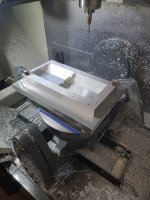There are issues with a blower/boost application on the 454 setups. The bore gets to be a wee bit thin. I have an LSX block in my yellow/street GTO. I built it as a 421 just to nod to the old days when Pontiac made the 421 SuperDuty. I went oversquare on that engine (4.1875" hole with a 3.825" stroke) and tossed a 3.0L Whipple blower onto it. The holes are good to around 20psi. Much north of that, you start playing with fire in terms of bore stability and the rings being able to do the work.
View attachment 7877193
I have a Dart LS Next tall deck block and a billet center counterweight crank sitting on the floor at home. I'm slowly acquiring the parts to do another engine. Looking at a 408 cubic inch setup for that thing. This latest motor is a test mule (of sorts) to see if that is worth pursuing. (stupid compression and 50+psi boost being the criteria that were trying out for this year) Assuming it all works, we'll pour the coals into that one. -Aluminum long rod set up and a pair of cylinder heads with ports big enough to park a bus in. Dry sump it, yada, yada.
The engine in the car now is still using cathedral port heads. -something I find to be hysterically funny as most will agree it's not the desired pathway. I've got more time/money in the stupid things now than anyone would ever want to admit to, but they seemed to work pretty well last year before I killed them.
That engine was a 5.3L. I swapped Jesel rockers last year and had to pull the heads to clear the valve cover rails. I built that engine using Athena head gaskets. Finding replacements was impossible, and we were trying like hell to make a particular race. Out of desperation, I rolled the dice and threw some ghetto Fel Pros on it. We were pleasantly surprised to discover that it worked pretty darn well. Then greed took over. . .
We started leaning on it with more boost/timing, and at 22psi, it said "uncle" and sneezed the head gasket and "gas axed" the deck surface (see welded head photo). I had a pair of old Lingenfelter prepped 243 factory heads that I'd bought in 2007. We slapped them on and actually went faster.
View attachment 7877194
Looking them over, I realized the chambers were much "softer" on the quench ring. The PRCs have massively thick deck surfaces, so there's plenty of meat to get creative. I made a model, and we increased the chamber volume by 7cc's and altered the angle on the quench pad to soften things up. The idea is that with big boost, the flame propagation needs to be slowed down a touch while avoiding dead spots for shit to loiter around in.
Make a fixture and get to work. . .
View attachment 7877197
Down the rabbit hole we go. . . Next chore was to 86 the head's water passages for the copper head gasket/hoops upgrade. The last bright idea was to scuff the intake runners to try and take advantage of something I'd seen 25 years ago. While in the Marines, I moonlighted at a few different race engine shops in Southern California. My first job as a civilian was up in Pamona, working for Bill Craddock doing head work. A pair of Ken Sperling prepared SBC "alky heads" showed up one day for a valve job. (Ken is/was the founder of Airflow Research) The intake ports literally looked as though they'd been ported with a backhoe. They had huge cusps, facets, and divets along the entire length of the runner. They were hideous to look at compared to anything I'd ever seen before.
They also moved air like nobody's business. That car hauled ass.
Remembering this, we attempted to emulate the same idea in these things. Long winters in S. Dakota, so we take advantage on the weekends.














